By accessing our 180 Days of Math for Fifth Grade Answers Key Day 149 regularly, students can get better problem-solving skills.
180 Days of Math for Fifth Grade Answers Key Day 149
Directions: Solve each problem.
Question 1.

Answer:
The addition is the term used to describe adding two or more numbers together. The addition is denoted using the plus sign ‘+‘ such as the addition of 3 and 3 can be written as 4 + 4. Also, the plus sign (+) can be used as many times as required, such as
4 + 4 + 4 + 4.
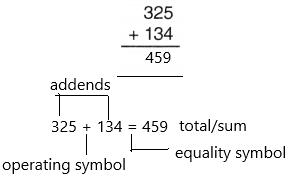
therefore, the answer is 459.
Question 2.
17 × 72 = ____________
Answer:
In mathematics, multiplication is a method of finding the product of two or more numbers. It is one of the basic arithmetic operations, that we use in everyday life. The major application we can see in multiplication tables.
In arithmetic, the multiplication of two numbers represents the repeated addition of one number with respect to another. These numbers can be whole numbers, natural numbers, integers, fractions, etc. If m is multiplied by n, then it means either m is added to itself ‘n’ a number of times or vice versa.
The formula for multiplication:
The multiplication formula is given by:
Multiplier × Multiplicand = Product
– The multiplicand is the total number of objects in each group
– A multiplier is the number of equal groups
– Product is the result of multiplication of multiplier and multiplicand
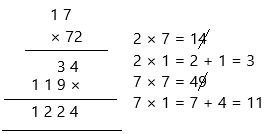
Therefore, the answer is 1224.
Question 3.
664 ÷ 7 = ___________
Answer:
The division is breaking a number into an equal number of parts. The division is an arithmetic operation used in Maths. It splits a given number of items into different groups.
There are a number of signs that people may use to indicate division. The most common one is ÷, but the backslash / and a horizontal line (-) are also used in the form of Fraction, where a Numerator is written on the top and a Denominator on the bottom.
The division formula is:
Dividend ÷ Divisor = Quotient (or) Dividend/Divisor=quotient
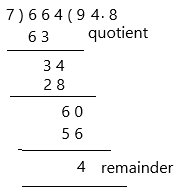
Therefore, the remainder is 4; and the quotient is 94.8
Question 4.
Round 35469 to the nearest thousand.
Answer:
– Let us consider one number (n) to round it to the nearest thousandth number
– Take the hundredth place digit of number n
– If the digit in the hundredth place is less than 5 i.e 0,1,2,3,4 then you need to round down that number by changing hundreds, tens and one’s digits to zero
– If the digit at the hundredth place of number is 5 or above 5 i.e 6,7,8,9 then you have to round up the number by adding 1 to the digit in thousandth position and zero at the hundreds, tens and ones place.
According to the above rules:
the answer is 35000.
Question 5.
Write 65% as a fraction.
Answer:
To convert 65% to a fraction follow these steps:
Step 1: Write down the per cent divided by 100 like this
65%=65/100
Step 2: Multiply both top and bottom by 10 for every number after the decimal point. As 65 is an integer, we don’t have numbers after the decimal point. So, we just go to step 3.
Step 3: simplify (or reduce) the above fraction by dividing both numerator and denominator by the GCD (greatest common divisor) between them. In this case, GCD(65,100) = 5. So,
(65 ÷ 10)/(100 ÷ 10) = 13/20 when reduced to the simplest form.
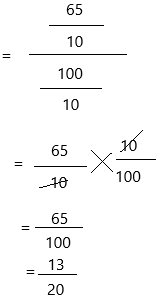
Question 6.
81 ÷ 9 + 56 ÷ 8 = ___________
Answer:
The value of 81 ÷ 9 is 9
The value of 56 ÷ 8 is 7

Now add the values we got. Assume that the answer is X.
X = 9 + 7
X = 16
Therefore, the answer is 16.
Question 7.

Answer:
Let the empty box be X.
Now the equation can be written as:
X + 4 = 38
Now get 4 to the right-hand side then the equation is
X = 38 – 4
X = 34.
Now substitute the X value in the equation.
X + 4 = 38
34 + 4 = 38
38 = 38
LHS = RHS
Hence, the answer is verified.
Question 8.
Could the volume of a room be 90 cm3 or 90 m3?
Answer:
Volume of a cuboid is the space occupied by its dimensions, inside the cuboid. These dimensions are length, width and height. When the area of the faces of a cuboid is the same, we call this cuboid a cube. The area of all the faces of a cube is the same as they are all squares.
the capacity of the room = volume of a cuboid
Volume of cuboid = l × b × h
It would be 90 cubic metres.
Question 9.
Is the angle greater than or less than 90°?
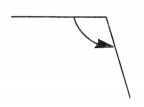
Answer:
the angle is greater. It is an obtuse angle.
In Mathematics, “an obtuse angle is an angle which is greater than 90 degrees and less than 180 degrees”. In other words, an obtuse angle is between a right angle and a straight angle.
Question 10.
What percentage of the total books did Jill read?
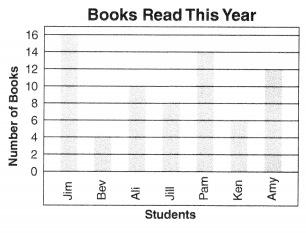
Answer:
the total number of books=16
The number of books Jill read = 8
We can use the formula to calculate the percentage easily and quickly. The formula to calculate the percentage is equal to the ratio of the actual value to the total value multiplied by 100.
Percentage, % = (Value / Total Value) × 100
Percentage, % = 8/16 × 100
Percentage, % = 1/2 × 100
Percentage, % = 50
Therefore, 50 per cent, i.e. 50% of the books has Jill read.
Question 11.
You place the following shapes in a bag: 5 circles, 3 triangles, 7 squares, and 5 rectangles. If you reach into the bag and grab one shape, what is the probability that it will not be a square?
Answer:
This formula is the number of favourable outcomes to the total number of all the possible outcomes that we have already decided in the Sample Space.
The probability of an Event = (Number of favourable outcomes) / (Total number of possible outcomes)
P(A) = n(E) / n(S)
P(A) < 1
Here, P(A) means finding the probability of an event A, n(E) means the number of favourable outcomes of an event and n(S) means the set of all possible outcomes of an event.
the total number of shapes = 5+3+7+5 =20
the favourable outcome of a square = 7
P(Square) = 7/20
The probability that the event will not occur or known as its failure is expressed as:
P(S’) = 1 – p( square )
P(S’) = 1-7/20
P(S’) = 1-0.35
P(S’) = 0.65
Therefore, the probability of not occurring in a square is 0.65
Question 12.
If you multiply me by 16, the product is 128. What number am I?
Answer:
Assume that number is P. Then the equation will be:
P × 16 =128
Now get 16 into the right-hand side then the 16 will be divided.
P = 128/16
P = 8
Now substitute P value in the above equation.
P × 16 =128
8 × 16 =128
128 = 128
LHS = RHS
Hence, the answer is verified.
Therefore, the number is 8.